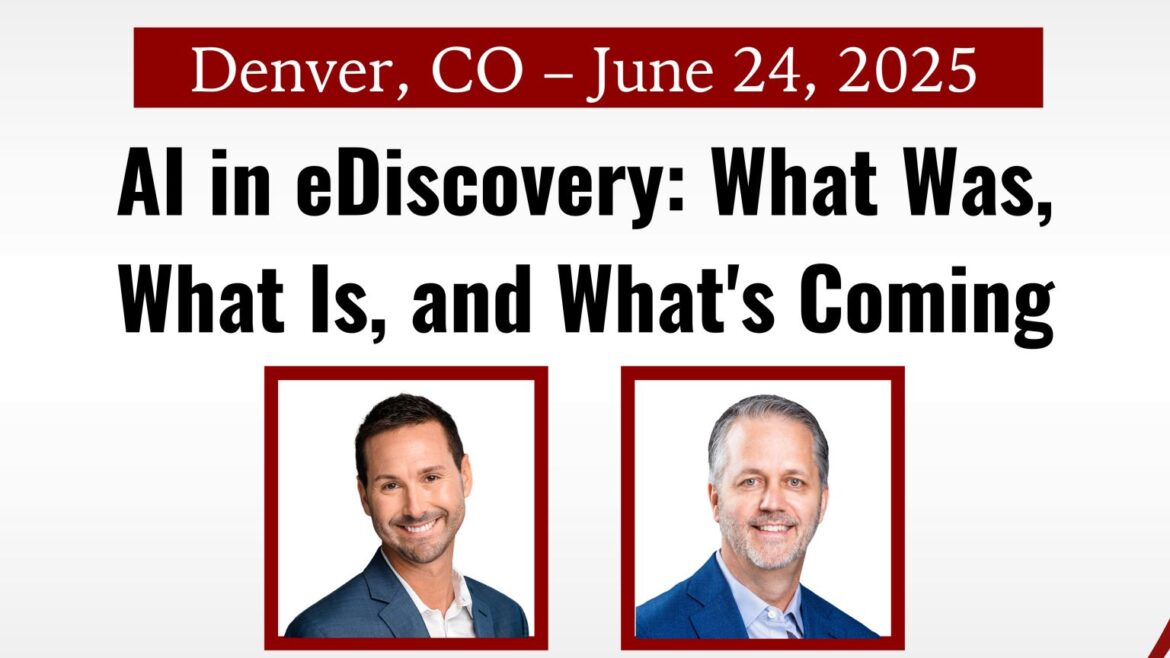eDiscovery Daily Blog
AI in eDiscovery: What Was, What Is, and What’s Coming
Insights from the Masters Conference – Denver | June 24, 2025 | Hosted by Fennemore Craig PC
Artificial Intelligence (AI) is no longer an emerging idea in legal discovery, it’s the present reality. At The Masters Conference in Denver, Fennemore Craig PC hosted an insightful session titled “AI in eDiscovery: What Was, What Is, and What’s Coming,” led by Adrian D’Amico, Director of Emerging Technology and Innovation, and Dean Seiveno, Chief Enterprise Officer. The session offered a sweeping view of how AI has evolved in the eDiscovery space and where it’s heading next.
The Evolution: From Automation to Insight
AI began reshaping eDiscovery by doing what humans couldn’t which is rapidly processing vast volumes of data. Early adoption focused on the automation of time-consuming processes like email and chat message review, issue identification, and document summaries. These tools gave legal teams the ability to cut through digital noise faster and more efficiently than ever before.
However, D’Amico pointed out that what we’re seeing now is a far cry from basic automation. The AI landscape and the technologists creating solutions is growing at an quick pace, leaving many overwhelmed and uncertain on which solutions, workflows and platforms should be considered.
D’Amico urged attendees to recognize that the real threat to your position or practice isn’t AI itself, it’s a lack of training in how to use it effectively. “AI doesn’t replace people,” D’Amico said. “A lack of AI training is what replaces people.”
Current Capabilities: Beyond Data Culling
Today’s AI-powered eDiscovery extends well beyond initial data sorting. It now plays a role across the entire EDRM spectrum:
- Identification & Preservation of sensitive data like PII
- Collection and early data analysis strategies that surface discoverable and relevant information early
- Processing and Analysis that leverage smart clustering and thematic analysis
- Review & Production tools that can visualize communication patterns, changes in sentiment, and emerging narratives that plug into traditional review and production workflows
One significant advancement is the shift from Continuous Active Learning (CAL) to Continuous Active Prompting (CAP). Unlike CAL, which trained models based on document coding decisions, CAP relies on natural language prompts. This allows legal teams to iterate prompts, create storyboards, uncover deeper context, and even analyze audio and video files and all through conversational interfaces.
Generative AI platforms like ChatGPT can now assist in:
- Drafting correspondence
- Extracting or testing legal arguments
- Modeling damages using curated eDiscovery datasets
But, D’Amico emphasized, only use firm-approved AI tools and never use a public tool for sensitive or proprietary information to maintain compliance and security.
The Future: Agentic AI and Multimodal Discovery
Looking ahead, both panelists predicted the rise of AI agents: automated systems that act like digital assistants within the eDiscovery workflow. These “Agentic AIs” will perform tasks like:
- Drafting privilege logs
- Reviewing batches of documents
- Monitoring quality control across platforms
- Create summaries of the documents, case arguments and organize data by topic
While these agents will still require human oversight, they represent a dramatic leap in efficiency and scalability.
Another exciting frontier is Multimodal Discovery which is the ability to connect and contextualize data across formats and cross channel communications. For example, searching for a keyword or concept could simultaneously pull in emails, Slack messages, call transcripts, and IoT data from wearables. This “search one, find all” approach has the potential to uncover layers of meaning and interconnectivity that were previously invisible.
Intent, Sentiment, and the Challenge of Ephemeral Data
Modern communications are rife with nuance like emojis, memes, GIFs, and slang interspersed throughout all textual conversations. Interpreting these requires more than a keyword search; it demands contextual intelligence. D’Amico described the importance of eDiscovering intent which is the ability of AI to read between the lines and identify tone, sentiment, or potential misconduct embedded in these short-form, symbolic messages.
Wearable technologies and IoT devices also present emerging data sources that, when analyzed correctly, can provide additional context around behavior, location, and anomalies tied to key events.
Adoption Trends and Practical Guidance
Citing the ILTA 2024 eDiscovery Survey, Seiveno noted that:
- 76% of large law firms and 46% of midsize firms are already using AI in some form for their practice
- Adoption varies across roles: 40% legal support, 22% attorneys, 63% paralegals
Legal professionals are at varying stages of their AI journey. “Just get started somewhere,” Seiveno advised. “Even small steps create momentum.”
He offered three core recommendations:
- Engage Clients – Create a one-page explainer to secure informed consent and highlight AI’s value.
- Offer Training – Ensure both legal and support teams are informed on emerging tools and workflows.
- Oversee Workflows – AI needs human oversight. Establish governance to validate outcomes and improve models.
Ethics and Compliance: Start with Policy
As AI becomes more embedded in legal practice, ethical boundaries and regulatory obligations must remain top of mind. The panel referenced several key sources:
- ABA Opinion 512 – Emphasizes duty to disclose the use of AI
- FRCP 11 – Requires “reasonable inquiry” in representations made to the court
- FRCP 37 – Addresses consequences for failing to disclose methods used
- In re Google Play Store Antitrust – A recent case highlighting the significance of transparency in AI use
Building policy starts with assessing existing tools, incorporating ABA guidance, promoting firm-wide enterprise AI solutions, and ensuring client data is kept fully siloed from other matters.
Final Thoughts
AI in eDiscovery is evolving from a helpful tool into a strategic advantage. But with this evolution comes the responsibility to educate, govern, and ethically apply these innovations. As D’Amico put it, “AI can surface things people wouldn’t even think to look for.” And that’s the key: not replacing human judgment, but enhancing it.
Whether you’re new to AI or already using it daily, one thing is clear: the future of discovery isn’t just data-driven—it’s AI-enabled, ethically informed, and client-focused.

